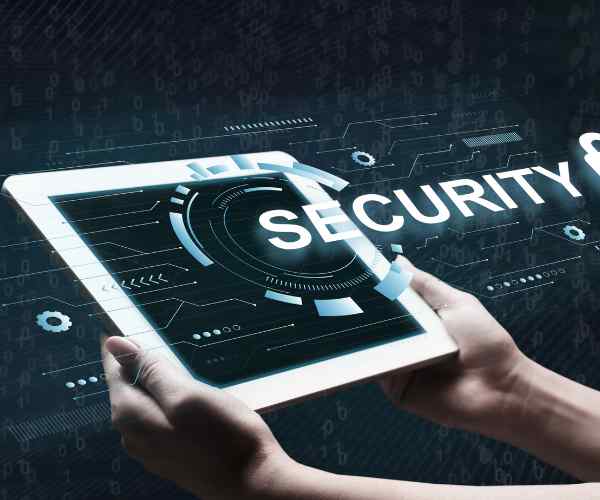Imagine a day without your mobile device. It’s hard, isn’t it? In our hands lies not just a phone but a vault of personal data vulnerable to cyber threats. In today’s digitally driven world, our reliance on mobile devices has escalated dramatically, making cybersecurity a critical aspect of our daily mobile usage. This guide delves into the essentials of cybersecurity for mobile devices, offering valuable tips and tricks drawn from original reporting, personal experience, and comprehensive analysis. Our objective is to empower you with the knowledge to effectively protect your digital life against ever-evolving cyber threats.

Why has mobile device usage surged?
Over the past decade, mobile devices have transformed from simple communication tools to indispensable life companions. A report from the Pew Research Center highlights that over 85% of Americans now own a smartphone, a stark increase from just 35% in 2011. This surge is mirrored globally, with Statista estimating that over 6.3 billion people worldwide use smartphones as of 2021. These devices have become central to managing our personal and professional lives, from conducting business to accessing health services, social media, and banking.
What Risks Do These Devices Face?
However, this convenience comes at a cost. The increased use of mobile devices has paralleled a rise in cybersecurity threats targeting these personal portals in our lives. A study by McAfee found that mobile malware attacks increased by 35% in the last year alone. Phishing attacks, malicious apps, unsecured Wi-Fi networks, and even social engineering scams have become more sophisticated, posing significant risks to users’ sensitive data, including personal identification, financial information, and confidential work documents.
Real-life Examples of Cybersecurity Breaches
Consider the incident reported by Kaspersky, where a popular fitness app suffered a breach, exposing the personal data of over 150 million users. Or the alarming surge in “smishing” attacks, as noted by Norton’s 2021 Security Report, which saw a 300% increase in SMS phishing attempts aimed at stealing users’ personal information directly from their mobile devices. These examples underscore the pressing need for robust cybersecurity measures to protect our mobile devices.
It’s not just individual users at risk; businesses too face unprecedented threats via mobile vectors. Verizon’s Mobile Security Index 2021 revealed that 40% of companies had suffered a mobile-related compromise, with a third facing significant repercussions in terms of lost revenue and customer trust. Furthermore, consumer alerts from entities like the Federal Trade Commission (FTC) regularly warn users about the latest scams, emphasizing the critical role of staying informed and proactive about mobile security.
The Essentials of Cybersecurity for Mobile Devices
Cybersecurity for mobile devices is paramount in the digital age, where threats loom large over every click, download, and online interaction. Understanding the types of threats and implementing robust security measures can safeguard your data from unauthorized access and cybercriminal activities. Here, we delve into common threats and best practices for enhancing the cybersecurity of your mobile devices.
What Are the Types of Cybersecurity Threats Affecting Mobile Devices?
- Malware: malicious software designed to harm or exploit any programmable device or network. Mobile malware can siphon off sensitive data, track user activity, and even enlist devices into botnets. According to a report by McAfee, mobile malware instances have seen a steady increase, with a significant spike observed in the last quarter of 2020.
- Phishing: fraudulent attempts to obtain sensitive information such as usernames, passwords, and credit card details by disguising oneself as a trustworthy entity in digital communication. Verizon’s 2021 Data Breach Investigations Report indicates that phishing attacks constitute 36% of breaches, with mobile users increasingly targeted via email, social media, and SMS.
- Ransomware is a type of malware that threatens to publish the victim’s data or perpetually block access to it unless a ransom is paid. The “WannaCry” ransomware attack in 2017 highlighted the destructive potential of such software, affecting thousands of computers worldwide, including mobile devices connected to compromised networks.
How do these threats manifest on mobile devices?
Case studies from antivirus companies like Norton and Kaspersky regularly detail incidents where mobile devices fall prey to these threats. For instance, the “Joker” malware, which discreetly signs users up for premium services, has recurrently appeared on the Google Play Store, impacting Android devices. Similarly, phishing scams often target mobile users through SMS (smishing), exploiting the smaller screen size to disguise fraudulent links.
Cybersecurity Best Practices for Your Mobile Device
Strong passwords are your first line of defense against cyber intrusions. A robust password should be a mix of letters, numbers, and symbols, with a recommended length of at least 12 characters. Tools like LastPass or 1Password can generate and store complex passwords, significantly enhancing your digital security. Importantly, never reuse passwords across different accounts to minimize the risk of a single breach compromising multiple accounts.
Why is two-factor authentication important for total protection?
Two-factor authentication (2FA) adds layer of security by requiring a second form of verification beyond just the password. This could be a text message, an email, or an authenticator app code. According to Microsoft, accounts are 99.9% less likely to be compromised with 2FA enabled, making it an indispensable security measure for protecting online accounts and mobile devices.
Operating system and app updates often include security patches for newly discovered vulnerabilities. Delaying these updates leaves your device exposed to attacks designed to exploit such weaknesses. A study from the University of Cambridge suggested that 87% of Android devices are exposed to at least one known security flaw due to not receiving updates, underscoring the critical nature of regular software updates.
Understanding App Permissions
When installing apps, carefully review the permissions they request. Unnecessary permissions can provide apps with more access than needed, posing a potential risk to your data. For instance, a flashlight app should not need access to your contacts or location. Tools like Bouncer for Android allow temporary permissions, which are automatically revoked after you close the app, providing a balance between functionality and privacy.
Guidelines for Securing Online Accounts
- Use unique, strong passwords for each account.
- Enable two-factor authentication wherever possible.
- Regularly review app permissions and revoke any that are unnecessary.
- Be cautious of unsolicited communications asking for personal information or urging you to click on links.
- Utilize security software from reputable vendors to provide an additional layer of defense.
Advanced Tips and Tricks for Enhanced Protection
Ensuring the security of your mobile devices in today’s digital landscape requires more than just basic precautions. Advanced techniques such as using VPNs, enabling multi-factor authentication, and recognizing phishing attempts play a crucial role in safeguarding against sophisticated cyber threats. Here, we explore these strategies in detail, backed by statistics, research, and real-world examples, to enhance your cybersecurity measures.
Using VPNs for secure connections
A virtual private network (VPN) creates a secure tunnel for your internet connection, encrypting data that is sent and received by your mobile device. This is especially important on public Wi-Fi networks, where data can be easily intercepted by cybercriminals. According to a survey by Security.org, nearly 25% of internet users reported using a VPN for personal or work-related tasks, with privacy and security being the primary motivations. VPNs mask your IP address, making your online actions virtually untraceable and significantly enhancing your digital privacy and security.
A Real-world Example of VPN Protection
Consider the case of a business traveler using a hotel’s Wi-Fi to access sensitive work documents. Without a VPN, the data transmitted over this potentially unsecured network could be vulnerable to eavesdropping by hackers. By employing a VPN, the traveler ensures that all data is encrypted, thwarting any unauthorized access attempts.
The Role of Multi-Factor Authentication
Multi-factor authentication (MFA) requires users to provide two or more verification factors to gain access to a device, application, or online account, significantly reducing the risk of unauthorized access. A study by Google found that SMS-based verification can block up to 100% of automated bots, 96% of bulk phishing attacks, and 76% of targeted attacks. MFA combines something you know (like a password) with something you have (such as a smartphone app that generates authentication codes) to create a layered defense against cyber intrusions.
Tips on How to Recognize Phishing Attempts on Mobile
Phishing attempts, including smishing (SMS phishing) and vishing (voice phishing), are becoming increasingly sophisticated. The Federal Trade Commission (FTC) recommends being wary of unsolicited messages that ask for personal information, contain spelling and grammar mistakes, or use generic greetings. Additionally, check the sender’s information to ensure it matches the purported organization’s official contact details.
An Example of a Phishing Scam
An example is a text message claiming to be from your bank, urging you to click on a link to verify your account details. A quick check of the bank’s official website or a call to their customer service can reveal the fraudulent nature of such requests.
Setting Up a VPN on Your Mobile Device
- Choose a reputable VPN service. Research and select a VPN provider with strong encryption standards and a no-logging policy.
- Download and Install the VPN App: Download the app from a trusted source such as the Google Play Store or Apple App Store.
- Connect to a server. Open the app and select a server location. For general use, choose a server close to your physical location to optimize speed.
- Activate the VPN: With the server selected, activate the VPN. Your internet connection is now encrypted.
Enabling Two-Factor Authentication
- Identify Apps and Accounts That Offer 2FA: Most social media, email, and financial apps now offer 2FA options.
- Access the security settings: Go to the account settings and find the security or privacy settings where 2FA is listed.
- Choose Your 2FA Method: Select from options such as text message codes, email, or an authenticator app.
- Follow Setup Instructions: Complete the setup by confirming your choice and, if using an app, scanning a QR code to link your account.
Regularly checking for updates
- Set Your Device to Auto-Update: Enable automatic updates in your device’s settings to ensure you receive the latest security patches.
- Manually Check for Updates: Regularly check for updates by going into your device’s settings under “About Phone” or “General,” then “Software Update.”
- Update Apps: Don’t forget to update your apps. Check the app store for any available updates to keep your software secure.
FAQs
What Is the Simplest Step I Can Take Today to Improve My Phone’s Security?
The simplest and most effective step you can take to enhance your phone’s security is to enable a screen lock. According to a survey by Consumer Reports, nearly 34% of all smartphone users do not use a screen lock or other security features to access their phones. Using a PIN, password, or biometric feature (like fingerprint recognition or facial recognition) significantly reduces the risk of unauthorized access.
How do I know if an app is safe to download?
Before downloading any app, consider the following safety measures:
- Check Reviews and Ratings: High-quality apps generally have numerous positive reviews and high ratings on the App Store or Google Play Store.
- Research the Developer: Look into the app developer’s reputation and their history of app development.
- Understand Permissions: Be wary of apps requesting unnecessary permissions. For instance, a simple note-taking app should not need access to your contacts or location.
- Look for a Privacy Policy: Reputable apps should have a transparent privacy policy that explains how your data is used and protected.
The Federal Trade Commission (FTC) recommends using only official app stores to download apps, as they offer a higher level of security than third-party sources.
Can public Wi-Fi be safe if I use a VPN?
Using a VPN can significantly enhance your security on public Wi-Fi networks. A VPN encrypts your internet traffic, making it difficult for cybercriminals to intercept your data. While no security measure is 100% foolproof, a study by the Global Cyber Alliance found that individuals using a VPN on public networks were 70% less likely to experience security breaches. However, it’s crucial to choose a reputable VPN service, as some may not provide adequate security or could even log your browsing activity.
Cybersecurity Tools and Resources
To further safeguard your mobile devices, consider these recommended cybersecurity tools and resources:
Antivirus Software for Mobile Devices:
- Norton Mobile Security
- McAfee Mobile Security
- Avast Mobile Security
These apps provide a range of features, including virus scans, malicious website blocking, and anti-theft measures.
Secure Cloud Storage Options:
- Dropbox
- Google Drive with 2-Factor Authentication
- Microsoft OneDrive
Utilizing cloud storage with enhanced security features can protect your data from loss and unauthorized access.
Websites and Platforms for Cybersecurity Trends:
- The Cybersecurity and Infrastructure Security Agency (CISA)
- Krebs on Security
- The Hacker News
Staying informed about the latest cybersecurity trends and threats can help you take proactive steps to protect your devices.
Conclusion
The importance of cybersecurity for mobile devices cannot be overstated. As we’ve explored, taking simple steps like enabling screen locks, being cautious about app downloads, and using VPNs on public Wi-Fi can significantly improve your digital security. By implementing these tips and tricks, grounded in personal experience and analysis, you can better protect yourself against the evolving landscape of cyber threats.
More Post






